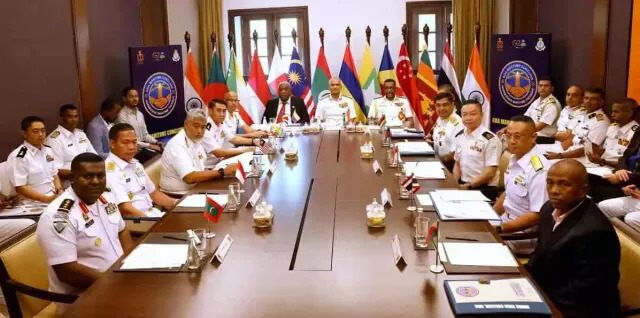The Indian Navy organised the fourth edition of the Goa Maritime Conclave (GMC) from 29 – 31 October to present the “harmonising and collaborating capacities and capabilities” in the Indian Ocean Region (IOR).
Held at the Naval War College, Goa, the conclave’s theme was “Maritime Security in the Indian Ocean Region: Converting Common Maritime Priorities into Collaborative Mitigating Frameworks.”
The event saw the participation of ministers, Chiefs of Navies, and heads of maritime forces from 12 IOR countries: Bangladesh, Comoros, Indonesia, Madagascar, Malaysia, Maldives, Mauritius, Myanmar, Seychelles, Singapore, Sri Lanka, and Thailand.
Comments from the Indian DM
Indian Defence Minister (DM) Rajnath Singh said in his keynote address that “common maritime priorities need to be addressed cooperatively by avoiding selfish interests that make the region less secure and less prosperous.”
“A free, open and rule-based maritime order is a priority for all of us. ‘Might is right’ has no place in such a maritime order. Adherence to international laws and agreements must be our lodestar,” Singh said.
He added that although “narrow immediate interests may tempt us to flout or disregard the well-established international law… doing so would lead to the breakdown of our civilised maritime relations.”
“Our common security and prosperity cannot be preserved without all of us committing to cooperatively adhering to the legitimate maritime rules of engagement. Fair rules of engagement are crucial for fostering collaboration and ensuring that no single country dominates others in a hegemonic manner,” Singh underscored.
To mitigate conflict on the high seas, Singh called for collaboration and the sharing of resources and expertise among nations, and building trust “through dialogues such as GMC, joint exercises, industrial collaboration, sharing of resources, [and] respecting international law.”
GOA MARITIME CONCLAVE (GMC) – 2023 CONCLUDES
— PIB India (@PIB_India) October 31, 2023
Indian Navy's Outreach Initiative for 'Harnessing Maritime Thought'
Maritime Security in the Indian Ocean Region: Converting Common Maritime Priorities into Collaborative Mitigating Frameworks
Read here: https://t.co/0RHVDbJMh6 pic.twitter.com/7vZRLY6vpk
Conclave Themes
Participating officials held deliberations on the following four sub-themes:
- Identifying Gaps in Regulatory and Legal Frameworks for Achieving Maritime Security in the IOR;
- Formulation of a Common Multi-lateral Maritime Strategy and Operating Protocols for GMC Nations for Collective Mitigation of Maritime Threats and Challenges;
- Identification and Establishment of Collaborative Training Programmes with Center of Excellence across the IOR;
- Leveraging Activities Pursued through Existing Multilateral Organisations in the IOR towards Generating Collective Maritime Competencies.
India and the IOR
In recent years, India has increasingly attempted to assert its influence in the IOR.
In 2016, the Indian Navy announced that it had formally commissioned the INS Arihant, a nuclear-powered ballistic missile submarine. The Arihant was also the first ballistic missile submarine to be built domestically by a country outside of the United Nations Security Council’s five permanent members.
In addition, it also operates another nuclear submarine, the INS Chakra II, which was acquired in 2012 on a 10-year lease from Russia. Further, the INS Arighat, India’s third nuclear submarine, is currently under construction.
India argues that these measures are a deterrence to rising Chinese influence in the international waters.

